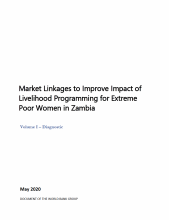Details
Article Type: Technical Paper
Target Audience: Policymaker, Researcher, Practitioner
Publisher/Author: World Bank Group
Sectors: Economic Inclusion, Gender
 Download PDF
Download PDF
Resources| Technical Guide| May 15, 2020
Market Linkages for Extreme Poor Women In Zambia - Volume 1: Diagnostic
While Zambia witnessed sustained economic growth since the early 2000s, this has not translated to improved livelihoods and well-being of the poor especially in rural areas with overall poverty stagnating around 50 percent (LCMS 2015). This is likely to have been exacerbated recently with the weakening of the economy, growing at about 1.7 percent in 2019. Rural women, and female headed households, are amongst the most disadvantaged—2/3 of them belong to the poorest 50 percent of population by consumption level and only about 20 percent have more than grade 8 education (LCMS 2015). Given this, the Government of Zambia through the Seventh National Development Plan 2018 has a strong focus on reducing extreme poverty and promoting human capital development, particularly that of women. The World Bank funded, Government of Zambia implemented, Girls’ Education and Women’s Livelihood (GEWEL) Project, was established to do just this through its focus on adolescent girl education and women’s livelihood. GEWEL’s Supporting Women’s Livelihood (SWL) component, is modeled on BRAC’s ‘big-push’ Targeting the Ultra-Poor (TUP) program. SWL provides each beneficiary a bundled intervention comprising of a one-time productive grant of US$ 225, life and business skills training, savings groups facilitation and mentoring. While short- and medium-term impacts of this type of programming on productive outcomes is strong, evolving global evidence points to mixed results on longer term sustainability albeit households headed by women doing better than those headed by men. (State of Economic Inclusion Report 2020) An impact evaluation is being undertaken of the SWL initiative and while the evaluation results are yet to be determined, evidence from other similar programs is a useful indication of potential long-term sustainability of impacts. In this report, we explore opportunities for market linkages for these extreme poor women to sustain the ‘big-push’ provided by the SWL initiative.

